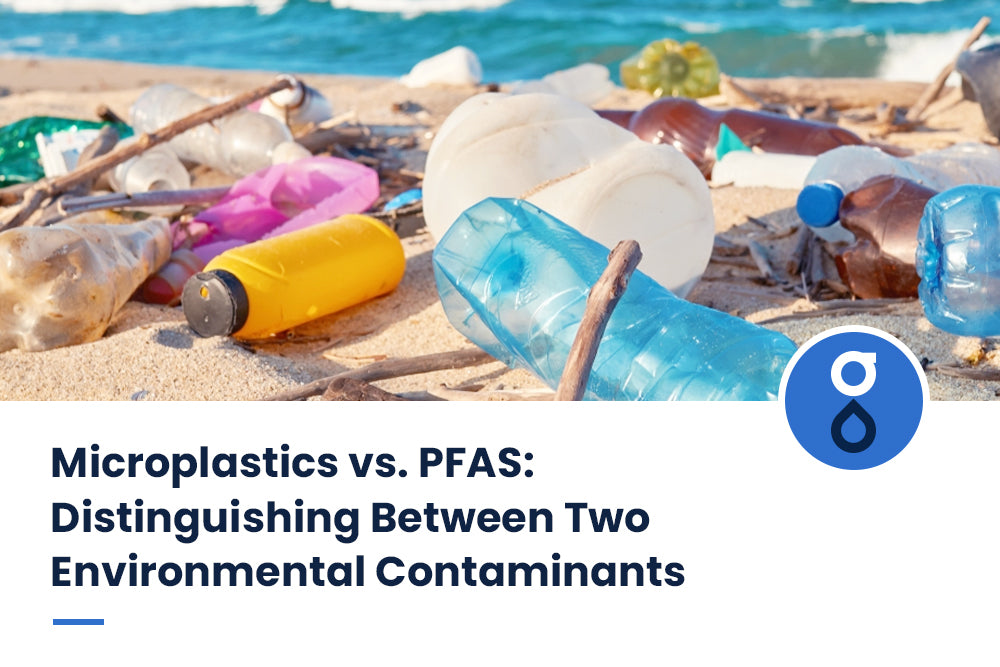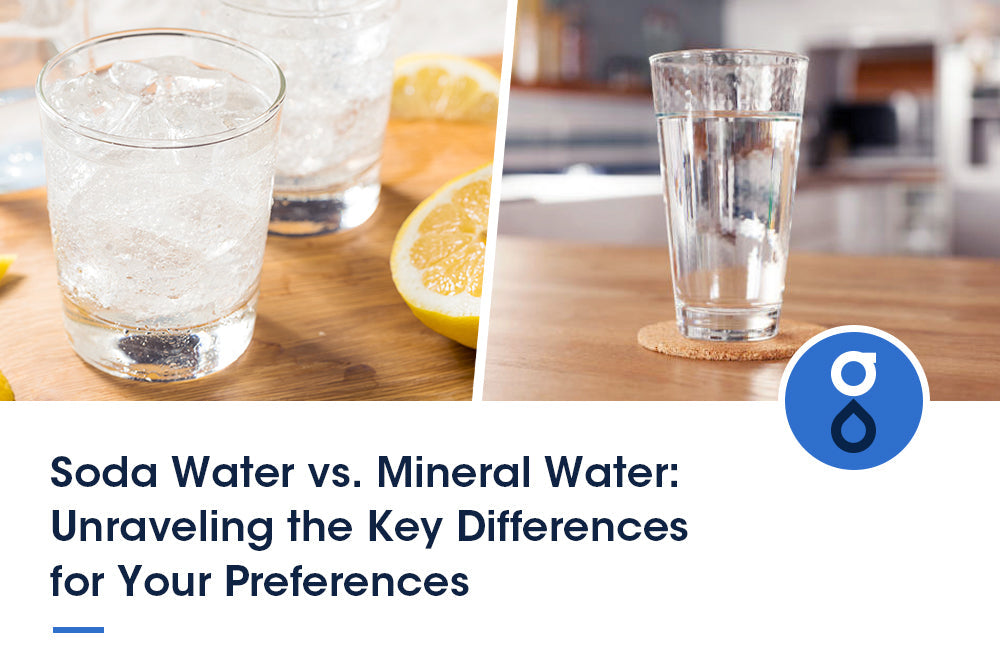Table of Contents:
What are microplastics?
Understanding PFAS
Microplastics VS PFAS, what`s the difference?
Potential risks of microplastics and PFAS
Strategies for reducing microplastics and PFAS
FAQs
Conclusion
Do you know the difference between microplastics and PFAS? These two environmental pollutants have been making headlines in recent years, and it's essential to understand their distinct characteristics and potential risks. Microplastics are tiny pieces of plastic that measure less than 5 millimeters in length. They can come from various sources, including broken-down oversized plastic items, microbeads in personal care products, and fibers from synthetic clothing.
On the other hand, PFAS (per and poly-fluoroalkyl substances) are a group of artificial chemicals used in a wide range of products, such as non-stick cookware, stain-resistant fabrics, and firefighting foam. While they serve valuable purposes, PFAS have been linked to a range of health problems and environmental concerns. By understanding the differences between microplastics and PFAS, you can make informed decisions about reducing exposure to these pollutants.
What are microplastics?

Microplastics are tiny pieces of plastic from various sources, including clothing, packaging, and personal care products. These plastics are less than 5 millimeters in size and can be easily ingested by marine life. They are also found in many of the foods we eat, such as fish and shellfish, as well as in the water we drink. There are two types of microplastics: primary microplastics and secondary microplastics. Primary microplastics, such as microbeads found in personal care products, are directly released into the environment.
Secondary microplastics result from more oversized plastic items breaking down into smaller pieces over time. Regardless of their source, both microplastics harm marine life and the environment. The impact of microplastics on human health is still being studied, but research has shown that these tiny particles can accumulate in the body and potentially cause harm.
In addition to the negative impact on marine life and the environment, microplastics are a growing concern for human health. It's essential to be mindful of the sources of microplastics and take steps to reduce our use of plastics overall.
Understanding PFAS

Although they may not be as widely recognized, PFAS are a class of chemicals that pose a significant threat to human health and the environment. PFAS, or per and poly-fluoroalkyl substances, are artificial chemicals commonly used in a variety of consumer products, such as non-stick cookware, stain-resistant furniture and clothing, and firefighting foam.
Despite their widespread use, PFAS are known to have harmful effects on human health, including increased risk of cancer, liver damage, and immune system dysfunction. PFAS awareness has grown recently as studies have revealed environmental contamination and potential health risks. PFAS can accumulate in soil and water and persist in the environment for decades, leading to widespread contamination. In response, regulatory measures have been implemented to limit or ban the use of certain
PFAS chemicals and require testing and monitoring of PFAS levels in drinking water and other environmental sources. As concerns about PFAS continue growing, industries and consumers are looking for safer chemical alternatives. Some companies have already begun phasing out the use of PFAS in their products, and researchers are exploring alternative chemicals and materials that can provide the same benefits without harmful effects. By raising awareness of PFAS and promoting safer alternatives, we can help reduce exposure risks and protect our health and the environment.
Microplastics VS PFAS, what`s the difference?
Microplastics and PFAS are contaminants that pose risks to the environment and human health, but they have distinct differences that should be properly understood.
Sources and applications
Microplastics are plastic particles less than 5mm in size, coming from various sources, such as the breakdown of larger plastics, plastic production, and even our clothes. On the other hand, PFAS (per and poly-fluoroalkyl substances) are a class of synthetic chemicals widely used in various industrial and consumer products, such as firefighting foam, food packaging, and even waterproof clothing.
Composition and properties
In terms of composition, microplastics are made up of a variety of plastic types, including polyvinyl chloride (PVC), polyethylene terephthalate (PET), and polystyrene, among others. PFAS, on the other hand, are composed of carbon, fluorine, and often a few other elements. Regarding their properties, microplastics can interact with other chemicals and organisms in aquatic environments.
They can also absorb hydrophobic pollutants, posing risks to marine organisms and even humans who consume contaminated seafood. PFAS compounds have high persistence and mobility in the environment, making removing them from drinking water sources difficult. Exposure to high levels of PFAS has been linked to several adverse health effects, including cancers, liver and thyroid disease, and mental illness.
Environmental effects

Microplastics have been found in oceans, rivers, and even the air we breathe. They are ingested by marine animals, which can lead to reduced growth, reproductive problems, and death. Microplastics can also make their way into the food chain; humans are not exempt from this. Studies have shown that humans consume microplastics in seafood, bottled water, and air. The long-term effects of consuming microplastics still need to be fully understood, but it needs to be better.
On the other hand, PFAS are known as "forever chemicals" because they do not break down easily and can persist in the environment for centuries. They have been linked to various health problems like kidney and testicular cancer, thyroid disease, and immune system problems. PFAS can also contaminate drinking water, and it is estimated that over 100 million Americans are exposed to PFAS through their drinking water. The impact of PFAS pollution is not limited to humans, as it can also affect wildlife, such as fish, birds, and even polar bears.
Potential risks of microplastics and PFAS
Microplastics can have several potential risks to the environment and aquatic ecosystems, mainly because of their small size. They can be ingested by marine life, leading to adverse effects such as reduced growth, reproductive failure, and even death. Additionally, microplastics have the potential to adsorb toxic chemicals in the water and transfer them to marine life that consumes them, effectively acting as a vector for transporting other contaminants.
Similarly, PFAS can also pose risks to the environment and human health, mainly due to their ability to persist for long periods in the background and their highly mobile nature. These substances can enter the water supply through sources such as firefighting foams and then contaminate drinking water sources, leading to potential adverse health effects such as liver damage, developmental delays, and even cancer.
Moreover, PFAS can also have harmful effects on wildlife, including both marine and aquatic life. For example, studies have shown that PFAS exposure can adversely affect the immune response of marine mammals such as Phocoena phocoena and Phocoenoides dalli. These contaminants can be exposed through different pathways, such as contact with water, food, and air.
For example, exposure to microplastics can occur through consuming or inhaling seafood. PFAS exposure, on the other hand, can occur through ingestion of contaminated drinking water or contact with colored plastic. Both microplastics and PFAS are contaminants that pose potential risks to human health and the environment. By understanding their potential risks and reducing exposure pathways, we can mitigate the adverse effects of these emerging contaminants.
Strategies for reducing microplastics and PFAS
Implementing sustainable lifestyle choices

To effectively reduce exposure to harmful substances like microplastics and PFAS, consider implementing sustainable lifestyle choices such as using reusable containers or water filters like reverse osmosis system, avoiding single-use plastics, and purchasing natural and non-toxic materials. Consumer awareness is also crucial in reducing exposure to these substances.
Research shows that many people are unaware of the potential risks associated with microplastics and PFAS. Educating consumers about these substances' dangers and the importance of sustainable choices can create a demand for safer products.
Redesign products and improve waste management

Product redesign and waste management are essential strategies for reducing exposure to microplastics and PFAS. Companies can redesign their products to eliminate the use of these substances. For example, many companies have used plant-based materials instead of traditional plastics. Proper waste management is also crucial in reducing the amount of microplastics and PFAS in our environment. Properly disposing of products containing these substances can prevent them from entering our waterways and food chain.
Legislate and make scientific research
Legislative action and scientific research are also necessary to address the issue of microplastics and PFAS. Governments can pass laws and regulations restricting the use of these substances in products. Scientific research can also help us better understand the risks associated with these substances and develop safer alternatives. By working together, we can reduce our exposure to microplastics and PFAS and create a safer and more sustainable future.
FAQs
How do microplastics and PFAS impact marine ecosystems?
When it comes to the impact of microplastics and PFAS on marine ecosystems, both can have serious consequences. Microplastics, tiny pieces of plastic less than 5mm in size, can accumulate in food chains and cause harm to biodiversity. They are also challenging to remove from the ocean due to their small size and can persist in the environment for hundreds of years.
PFAS, on the other hand, is a group of chemicals used in various consumer products that can have toxic effects on marine life and accumulate in the food chain. They are highly persistent and can travel long distances through air and water, making them a global issue. Mitigation strategies for both microplastics and PFAS include reducing the sources of pollution and improving waste management practices.
Can microplastics and PFAS be recycled or reused in any way?
Did you know that there are recycling options for both microplastics and PFAS? While it may seem challenging to recycle such tiny particles, companies and organizations are developing ways to upcycle and repurpose them. For example, some companies use microplastics to create new products, such as clothing and building materials.
Additionally, PFAS can be reused in industrial processes, such as in the production of semiconductors. These circular economy solutions not only reduce waste but also help to mitigate the negative impacts of microplastics and PFAS on the environment. We can work towards a more sustainable future by implementing waste reduction strategies and finding innovative ways to repurpose these materials.
Are there any regulations in place to limit the use of microplastics and PFAS?
Regulations have been implemented to limit the use of microplastics and PFAS due to their negative environmental impact. The industry is responsible for finding alternatives to these substances and ensuring that they aren't harmful to the environment.
Consumer awareness has also played a role in pushing for more sustainable and eco-friendly products. Companies must take action and reduce their use of these substances to protect our planet. With stricter regulations and a focus on sustainability, we can work towards a cleaner and healthier future.
Conclusion
Now that you're better understood both microplastics and PFAS, it's essential to consider the potential risks associated. Microplastics can harm the environment and wildlife, potentially enter the food chain and affect human health. On the other hand, PFAS has been linked to various health issues, such as cancer and reproductive problems. To reduce the impact of microplastics and PFAS, there are several strategies you can implement.
Additionally, avoiding products that contain PFAS and advocating for stricter regulations can help limit exposure to these harmful chemicals. By taking action with Glacier Fresh and making conscious choices, you can play a role in protecting both the environment and your health.
















